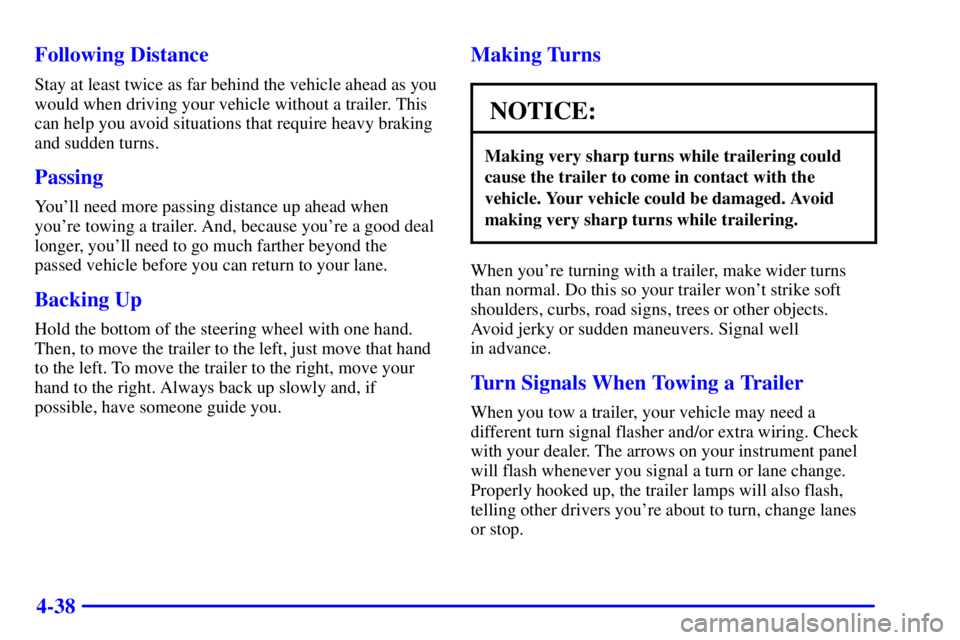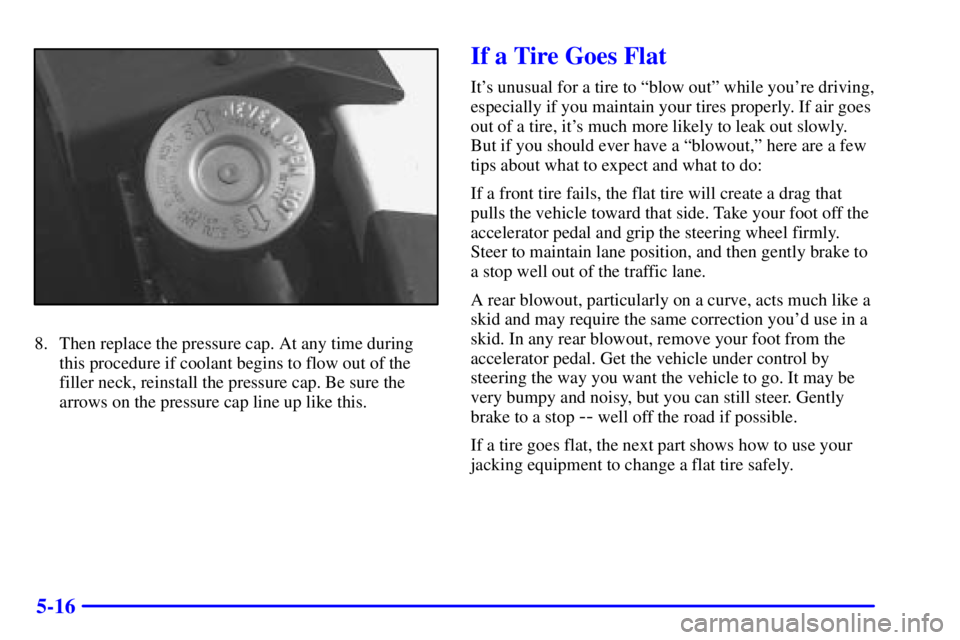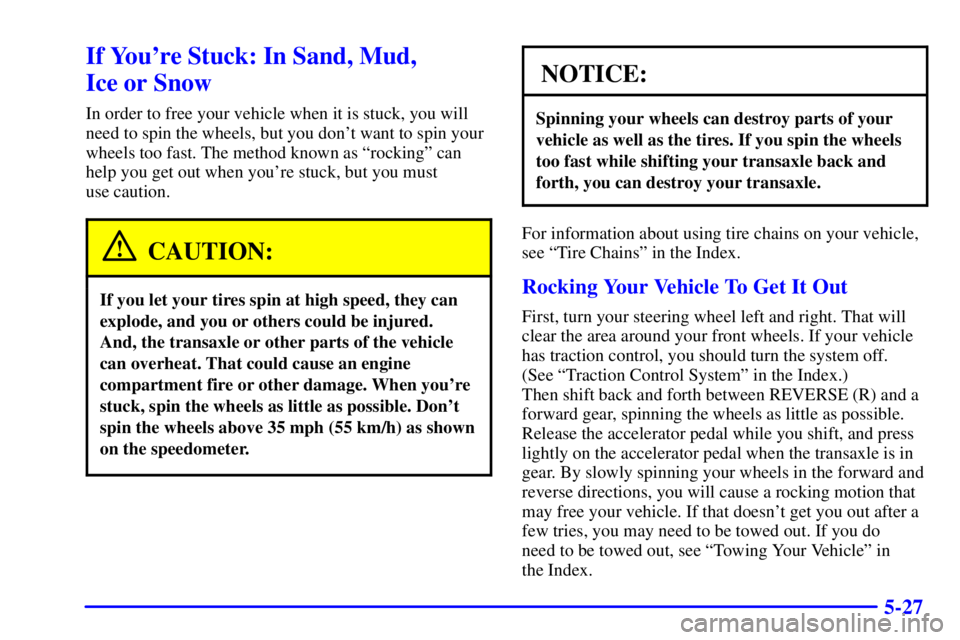Page 233 of 392

4-38 Following Distance
Stay at least twice as far behind the vehicle ahead as you
would when driving your vehicle without a trailer. This
can help you avoid situations that require heavy braking
and sudden turns.
Passing
You'll need more passing distance up ahead when
you're towing a trailer. And, because you're a good deal
longer, you'll need to go much farther beyond the
passed vehicle before you can return to your lane.
Backing Up
Hold the bottom of the steering wheel with one hand.
Then, to move the trailer to the left, just move that hand
to the left. To move the trailer to the right, move your
hand to the right. Always back up slowly and, if
possible, have someone guide you.
Making Turns
NOTICE:
Making very sharp turns while trailering could
cause the trailer to come in contact with the
vehicle. Your vehicle could be damaged. Avoid
making very sharp turns while trailering.
When you're turning with a trailer, make wider turns
than normal. Do this so your trailer won't strike soft
shoulders, curbs, road signs, trees or other objects.
Avoid jerky or sudden maneuvers. Signal well
in advance.
Turn Signals When Towing a Trailer
When you tow a trailer, your vehicle may need a
different turn signal flasher and/or extra wiring. Check
with your dealer. The arrows on your instrument panel
will flash whenever you signal a turn or lane change.
Properly hooked up, the trailer lamps will also flash,
telling other drivers you're about to turn, change lanes
or stop.
Page 251 of 392

5-16
8. Then replace the pressure cap. At any time during
this procedure if coolant begins to flow out of the
filler neck, reinstall the pressure cap. Be sure the
arrows on the pressure cap line up like this.
If a Tire Goes Flat
It's unusual for a tire to ªblow outº while you're driving,
especially if you maintain your tires properly. If air goes
out of a tire, it's much more likely to leak out slowly.
But if you should ever have a ªblowout,º here are a few
tips about what to expect and what to do:
If a front tire fails, the flat tire will create a drag that
pulls the vehicle toward that side. Take your foot off the
accelerator pedal and grip the steering wheel firmly.
Steer to maintain lane position, and then gently brake to
a stop well out of the traffic lane.
A rear blowout, particularly on a curve, acts much like a
skid and may require the same correction you'd use in a
skid. In any rear blowout, remove your foot from the
accelerator pedal. Get the vehicle under control by
steering the way you want the vehicle to go. It may be
very bumpy and noisy, but you can still steer. Gently
brake to a stop
-- well off the road if possible.
If a tire goes flat, the next part shows how to use your
jacking equipment to change a flat tire safely.
Page 262 of 392

5-27
If You're Stuck: In Sand, Mud,
Ice or Snow
In order to free your vehicle when it is stuck, you will
need to spin the wheels, but you don't want to spin your
wheels too fast. The method known as ªrockingº can
help you get out when you're stuck, but you must
use caution.
CAUTION:
If you let your tires spin at high speed, they can
explode, and you or others could be injured.
And, the transaxle or other parts of the vehicle
can overheat. That could cause an engine
compartment fire or other damage. When you're
stuck, spin the wheels as little as possible. Don't
spin the wheels above 35 mph (55 km/h) as shown
on the speedometer.
NOTICE:
Spinning your wheels can destroy parts of your
vehicle as well as the tires. If you spin the wheels
too fast while shifting your transaxle back and
forth, you can destroy your transaxle.
For information about using tire chains on your vehicle,
see ªTire Chainsº in the Index.
Rocking Your Vehicle To Get It Out
First, turn your steering wheel left and right. That will
clear the area around your front wheels. If your vehicle
has traction control, you should turn the system off.
(See ªTraction Control Systemº in the Index.)
Then shift back and forth between REVERSE (R) and a
forward gear, spinning the wheels as little as possible.
Release the accelerator pedal while you shift, and press
lightly on the accelerator pedal when the transaxle is in
gear. By slowly spinning your wheels in the forward and
reverse directions, you will cause a rocking motion that
may free your vehicle. If that doesn't get you out after a
few tries, you may need to be towed out. If you do
need to be towed out, see ªTowing Your Vehicleº in
the Index.
Page 337 of 392

6-75
Capacities and Specifications
The following approximate capacities are given in English and metric conversions. Please refer to ªRecommended
Fluids and Lubricantsº in the Index for more information.
Automatic Transaxle AT (Overdrive)
Pan Removal and Replacement 6.0 quarts (5.6 L). . . . . . . . . . . . . . . . . . . . . . . . . . . . . . . . . . . . . . . . . . . . . . . .
After Complete Overhaul 11.0 quarts (10.4 L). . . . . . . . . . . . . . . . . . . . . . . . . . . . . . . . . . . . . . . . . . . . . . . . . . .
After performing either transaxle procedure, check fluid level when done. More fluid may be needed.
Belt Tensions
Automatically controlled by a self
-tension idler pulley. Tension adjustment should never be necessary.
Cooling System13.0 quarts (12.3 L) . . . . . . . . . . . . . . . . . . . . . . . . . . . . . . . . . . . . . . . . . . . . . . . . . . . . . . . . . . .
Engine Crankcase
Oil change with filter change 4.5 quarts (4.3 L). . . . . . . . . . . . . . . . . . . . . . . . . . . . . . . . . . . . . . . . . . . . . . . . .
Fuel Tank18.5 gallons (70.0 L) . . . . . . . . . . . . . . . . . . . . . . . . . . . . . . . . . . . . . . . . . . . . . . . . . . . . . . . . . . . . . . .
Power Steering
Pump Only1.0 pint (0.5 L) . . . . . . . . . . . . . . . . . . . . . . . . . . . . . . . . . . . . . . . . . . . . . . . . . . . . . . . . . . . . . . . . .
Complete System 1.5 pints (0.7 L). . . . . . . . . . . . . . . . . . . . . . . . . . . . . . . . . . . . . . . . . . . . . . . . . . . . . . . . . . .
Wheel Nut Torque100 lb
-ft (140 N´m) . . . . . . . . . . . . . . . . . . . . . . . . . . . . . . . . . . . . . . . . . . . . . . . . . . . . . . . .
Tire Pressure
See Tire
-Loading Information label on the rear edge of the driver's door.
Air Conditioning Refrigerant
See refrigerant charge label under the hood.
All capacities are approximate. When adding, be sure to fill to the appropriate level as recommended in this manual.
Page 339 of 392

6-77
Normal Maintenance
Replacement Parts
Air Cleaner Filter AC Type A-1096C . . . . . . . . . . . . .
Engine Oil Filter AC Type PF
-47 . . . . . . . . . . . . . . . .
Fuel Filter AC Type GF
-627 . . . . . . . . . . . . . . . . . . . .
Spark Plugs AC Type 41
-921* . . . . . . . . . . . . . . . . . .
Gap 0.060 inch (.152 cm)
Windshield Wiper Blades
Type Hook Style. . . . . . . . . . . . . . . . . . . . . . . . . . . .
Length 22 inches (56 cm). . . . . . . . . . . . . . . . . . . . .
Passenger Compartment Air Filter
(HVAC air filter) GM Part No. 52472175. . . . . . . . .
*On 3800 Supercharged Engine (Code 1) only, this
replaces original spark plug NGK Type PTR4B
-15.
Vehicle Dimensions
Length 206.8 inches (525.3 cm). . . . . . . . . . . . . . . . .
Width 74.7 inches (189.7 cm). . . . . . . . . . . . . . . . . . .
Height 57.4 inches (145.8 cm). . . . . . . . . . . . . . . . . . .
Wheelbase 113.8 inches (289.1 cm). . . . . . . . . . . . . .
Front Tire Tread 62.7 inches (159.3 cm). . . . . . . . . . .
Rear Tire Tread 62.3 inches (158.2 cm). . . . . . . . . . .
Engine Accessory Belt (L36)
The L36 engine uses an engine accessory belt. This
diagram shows the features connected and the routing.
See ªMaintenance Scheduleº in the Index for when to
check the belt.
A. Power Steering
B. Generator
C. Air ConditioningD. Crank
E. Water Pump
F. Tensioner
Page:
< prev 1-8 9-16 17-24